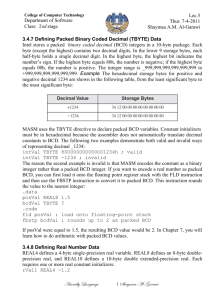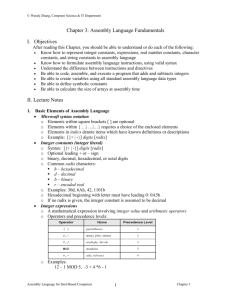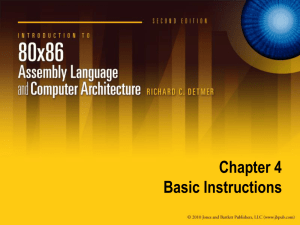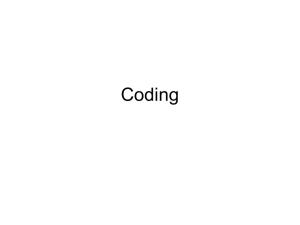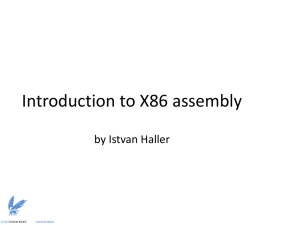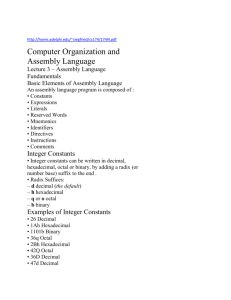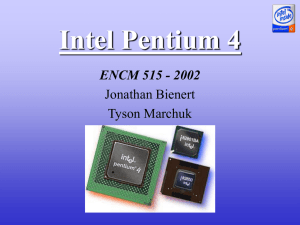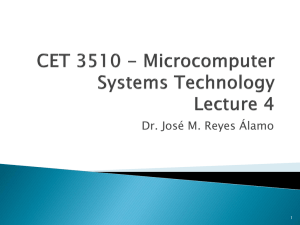Chapter3
advertisement
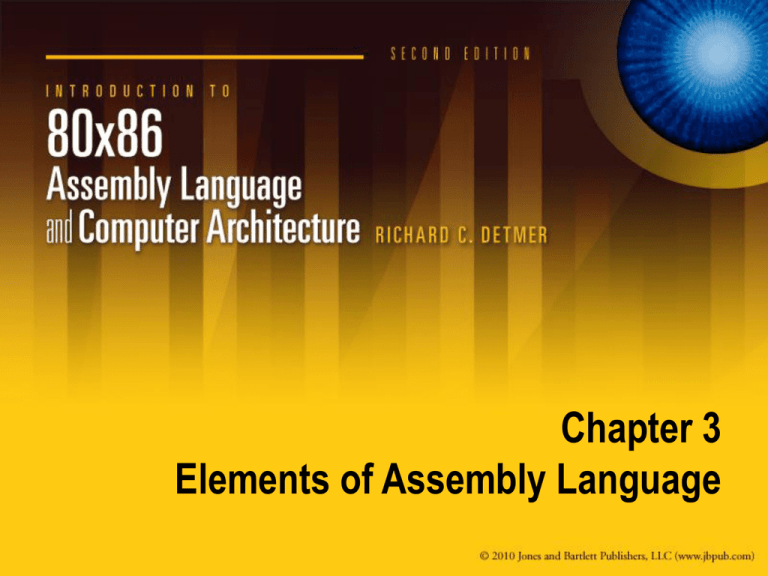
Chapter 3 Elements of Assembly Language 3.1 Assembly Language Statements Assembly Language Statements comments directives instructions directives ; Program to add 158 to number in memory ; Author: R. Detmer Date: 1/2008 .586 .MODEL FLAT .STACK 4096 ; reserve 4096-byte stack .DATA ; reserve storage for data number DWORD -105 sum DWORD ? .CODE ; start of main program code main PROC mov eax, number ; first number to EAX add eax, 158 ; add 158 mov sum, eax ; sum to memory mov eax, 0 ; exit with return code 0 ret main ENDP comments END Comments • Start with a semicolon (;) • Extend to end of line • May follow other statements on a line Instructions • Each corresponds to a single instruction actually executed by the 80x86 CPU • Examples – mov eax, number copies a doubleword from memory to the accumulator EAX – add eax, 158 adds the doubleword representation of 158 to the number already in EAX, replacing the number in EAX Directives • Provide instructions to the assembler program • Typically don’t cause code to be generated • Examples – .586 tells the assembler to recognize 32-bit instructions – DWORD tells the assembler to reserve space for a 32-bit integer value Macros • Each is “shorthand” for a sequence of other statements – instructions, directives or even other macros • The assembler expands a macro to the statements it represents, and then assembles these new statements • No macros in this sample program Typical Statement Format • name mnemonic operand(s) ; comment – In the data segment, a name field has no punctuation – In the code segment, a name field is followed by a colon (:) • Some statements omit some of these fields Identifiers • Identifiers used in assembly language are formed from letters, digits and special characters – Special characters are best avoided except for an occasional underscore • An identifier may not begin with a digit • An identifier may have up to 247 characters • Restricted identifiers include instruction mnemonics, directive mnemonics, register designations and other words which have a special meaning to the assembler Program Format • Indent for readability, starting names in column 1 and aligning mnemonics and trailing comments where possible • Assembler code is not case-sensitive; but good practice is to – Use lowercase letters for instructions – Use uppercase letters for directives 3.2 A Complete 32-bit Example Using the Debugger Using Visual Studio • Open the console32 project to see Using Visual Studio • Add a new source code file Must use .asm extension Using Visual Studio • Type or copy/paste source code • Breakpoint at first instruction Click here to set breakpoint Using Visual Studio • Launch execution with F5 Enter address &number to see memory starting at number Use Debug/Window to open debug windows Using Visual Studio • Step through program by pressing F10 • Each time an instruction is executed, register or memory contents may change – Changed values turn red • The instruction pointer EIP will change each time to the address of the instruction to be executed • The flags register EFL (EFLAGS) will change if an instruction affects flags Debugger Memory Display • Shows the starting memory address for each line • Shows two hex digits for each byte memory byte – If the byte can be interpreted as a printable ASCII character, that character is displayed to the right – Otherwise, a period is displayed to the right Output of Assembler • Object file, e.g., example.obj – Contains machine language statements almost ready to execute • Listing file, e.g., example.lst – Shows how the assembler translated the source program Listing File locations of data relative to start of data segment 8 bytes reserved for data, with first doubleword initialized to -105 00000000 00000000 FFFFFF97 00000004 00000000 00000000 00000000 00000000 A1 00000000 00000005 05 0000009E 0000000A A3 00000004 locations of instructions relative to start of code segment .DATA number DWORD sum DWORD .CODE main PROC R mov add R mov -105 ? eax, number eax, 158 sum, eax object code for the three instructions Parts of an Instruction • Instruction’s object code begins with the opcode, usually one byte – Example, A1 for mov eax, number • Immediate operands are constants embedded in the object code – Example, 0000009E for add eax, 158 • Addresses are assembly-time; must be fixed when program is linked and loaded – Example, 00000004 for mov sum, eax 3.3 Data Declarations BYTE Directive • Reserves storage for one or more bytes of data, optionally initializing storage • Numeric data can be thought of as signed or unsigned • Characters are assembled to ASCII codes • Examples byte1 byte2 byte3 byte4 byte5 byte6 byte7 BYTE BYTE BYTE BYTE BYTE BYTE BYTE 255 ; value is FF 91 ; value is 5B 0 ; value is 00 -1 ; value is FF 6 DUP (?) ; 6 bytes each with 00 'm' ; value is 6D "Joe" ; 3 bytes with 4A 6F 65 DWORD Directive • Reserves storage for one or more doublewords of data, optionally initializing storage • Examples double1 double2 double3 double4 Double5 DWORD DWORD DWORD DWORD DWORD -1 -1000 -2147483648 0, 1 100 DUP (?) ; ; ; ; ; value is FFFFFFFF value is FFFFFC18 value is 80000000 two doublewords 100 doublewords WORD Directive • Reserves storage for one or more words of data, optionally initializing storage Multiple Operands • Separated by commas – DWORD 10, 20, 30 ; three doublewords • Using DUP – DWORD 100 DUP (?) ; 100 doublewords • Character strings (BYTE directive only) – BYTE “ABCD” ; 4 bytes 3.4 Instruction Operands Types of Instruction Operands • Immediate mode – Constant assembled into the instruction • Register mode – A code for a register is assembled into the instruction • Memory references – Several different modes Memory References • Direct – at a memory location whose address is built into the instruction – Usually recognized by a data segment label, e.g., mov sum, eax (here eax is a register operand) • Register indirect – at a memory location whose address is in a register – Usually recognized by a register name in brackets, e.g., mov DWORD PTR [ebx], 10 (here 10 is an immediate operand) 3.5 a complete 32-bit example using Windows input/output windows32 framework • Program includes io.h which defines input/output macros • Main procedure must be called _MainProc • Example prompts for and inputs two numbers, adds them, and displays sum Example Program Data Segment .DATA number1 DWORD number2 DWORD prompt1 BYTE prompt2 BYTE string BYTE resultLbl BYTE sum BYTE ? ? "Enter first number", 0 "Enter second number", 0 40 DUP (?) "The sum is", 0 11 DUP (?), 0 Program Code Segment (1) .CODE _MainProc PROC input prompt1, string, 40 Displays dialog box Reads up to 40 characters into memory at string atod string Scans memory at string Converts to doubleword integer in EAX mov number1, eax Program Code Segment (2) mov add eax, number1 eax, number2 dtoa sum, eax Convert doubleword integer in EAX to 11-byte-long string of spaces and decimal digits at sum output resultLbl, sum Display message box showing two strings Input and Output 3.6 input/output and data conversion macros defined in IO.H atod • Format: atod source • Scans the string starting at source for + or - followed by digits, interpreting these characters as an integer. The corresponding 2's complement number is put in EAX. dtoa • Format: dtoa destination, source • Converts the doubleword integer at source (register or memory) to an eleven-bytelong ASCII string at destination. The string represents the decimal value of the source number and is padded with leading spaces. input • Format: input prompt, destination, length • Generates a dialog box with label specified by prompt, where prompt references a string in the data segment. When OK is pressed, up to length characters are copied from the dialog box to memory at destination. output • Format: output labelMsg, valueMsg • Generates a message box with the label labelMsg, and valueMsg in the message area. Each of labelMsg and valueMsg references a string in the data segment. atow and wtoa • Similar to atod and dtoa, but for words instead of doublewords • Rarely needed since doublewords are the integer size of choice in current 80x86 systems. 3.7 64-bit examples console64 example • Similar to console32, but fewer directives ; Example assembly language program .DATA number QWORD -105 sum QWORD ? .CODE main PROC mov rax, number add rax, 158 mov sum, rax mov rax, 0 ret main ENDP END Debugger 64-bit addresses 64-bit registers 64-bit differences • “Direct” memory addressing is actually RIP relative – the 32-bit offset stored in the instruction is added to RIP to get the operand address • Extra code is required in windows64 programs sub rsp,120 ; reserve stack space for MainProc ... add rsp, 120 ; restore stack
